Abstract
From March 2020, Italians experienced lockdown due to COVID-19 pandemic. People had to share common living spaces with family members for an extended period converting their home into workplaces. This resulted in changes to everyday life noises with implications in terms of perception of indoor acoustic quality. An online survey was designed and distributed to Italian residents to assess how they perceived the indoor quality of domestic spaces when working from home. A total of 330 questionnaires were collected and analyzed. The paper reports the results of the analyses carried out, focusing on the acoustic quality in home spaces and the satisfaction of the respondents, including an analysis of the housing context. Most respondents attach great importance to the acoustic aspects in judging the quality of the living environment and believe that the acoustic quality can improve the performance of their work. The comparison between pre-lockdown and lockdown periods shows that noises inside the building prevail over those coming from the outside and annoyance is mainly due to noise from shared spaces. The results of this study highlighted how the COVID-19 lockdown was a unique opportunity to draw attention to the importance of the indoor acoustic quality.
Keywords:
house typology; acoustic quality; survey; well-being; COVID-19 lockdown; working from home 1. Introduction
The outbreak of the coronavirus pandemic (COVID-19) has had a huge global impact since it began in late 2019. Italians were the first European citizens to experience a lockdown in March 2020. People’s lifestyles were affected by the measures implemented in this regard, as they increased the time spent in their living environment and forced them to work from home for the first time; this inevitably had a subjective impact on the perception, satisfaction, and preference of indoor environmental quality (IEQ) [1]. Among other aspects, the acoustic perception also changed [2]. On the one hand, many studies from different countries [3,4,5,6,7,8] reported a positive effect in terms of reducing ambient noise due to the reduction of commercial activities, industry, traffic, and air travel. On the other hand, the lockdown had an opposite effect on neighborhood noise pollution, leading to an increase in noise complaints, as reported in a case study conducted in London [9]. This was mainly due to a change in people’s behaviors: more people were working from home, which led to an increase in activities such as home renovation projects, domestic entertainment, or simply the presence of family members or neighbors making noise during the day. In urban areas, such as parks and outdoors, natural sounds increased, previously masked by human noise pollution.
Since the beginning of the lockdown, dwellings have been adapted to new functions (sharing spaces where different activities take place), leading to an increased noise awareness [9,10] and consequently making building occupants differently vulnerable to the acoustic conditions in their homes [11].
As a result, the COVID-19 pandemic has had a complex impact on acoustic noise levels. Previous studies [12,13] confirmed this aspect, also focusing also on the influence of the year of construction of buildings with an overall better acoustics quality of buildings built after 2000. In contrast, other studies [4,11] focused on the impact of noise levels recorded during the pandemic and how these may affect people’s ability to work from home. In [4,11], in particular, attention was paid to how other people, children, or animals present in the home may affect the ability to working from home.
The aim of this work based on a survey conducted in Italy during the lockdown period from April to June 2020 [1] is to investigate all the above-mentioned issues (buildings’ year of construction, presence of other people in the home, and comparison between acoustic perception before and during the pandemic). Therefore, it is to contribute to the study of the acoustic comfort and protection against noise in dwellings used as a working place. Indeed, the pandemic provided a significant opportunity to study noise issues in residential buildings, as more time was spent at home and consequently the duration of exposure to all existing noise sources increased. The main objectives of the study include the identification of the noise sources that most affected occupant satisfaction, distinguishing between sources inside and outside dwellings and taking into account some building characteristics. In this paper, a comparison was made between lockdown and pre-lockdown situations.
2. Materials and Methods
The survey underlying this work, conducted by the Construction Technologies Institute (ITC) of the National Research Council of Italy (CNR), aimed to evaluate the IEQ of the working from home (WFH) in Italy during COVID-19 lockdown, over a 3-month period, from April to June 2020. The questionnaire initially contained informed consent text. Participants were informed that the survey was anonymous, free of charge, voluntary and available on a GDPR-compliant platform. The questionnaire included questions on thermal comfort, lighting, Acoustic Quality (AQ), air quality and overall environmental comfort. The survey structure is described in detail in [1]. For the study described here, especially as regards the aspects related to acoustic perception, only the answers to the questions on AQ were analyzed in deeper detail, including the comparison with the pre-lockdown situation not investigated before, in addition to the more general ones related to personal data, building type, and living environment.
2.1. Questionnaire
ISO/TS 15666:2003 “Acoustics—Assessment of noise annoyance by means of social and socio-acoustic surveys”, provides specifications for socio-acoustic surveys and social surveys which include questions on noise effects. The questions indicated in this ISO/TS standard refer to a period of 12 months. A typical question is: “Thinking about the last (12 months or so), when you are at home, how much does noise from (noise source) bother, disturb or annoy you?”.
According to this indication, similar questions are asked in our questionnaire, suggesting thinking about the period before the lockdown.
The same questions with the same noise sources and the same possible answers described in Appendix A (in Table A1) are used for the comparison between the periods before the lockdown (pre-lockdown period) and during the lockdown, only related to the period before the lockdown.
A 5-point categorical unipolar scale with “Not perceived/not existing” as an answer alternative is defined for the answers to both questions (lockdown and pre-lockdown) with relative scores as indicated in Appendix A (in Table A1).
2.2. Sample Distribution
The questionnaire was made available on the ITC-CNR website and was open to all interested parties during the lockdown period, from April to June 2020. Three hundred and thirty respondents from all over Italy (Figure 1), with a higher concentration in Northern Italy, where the pandemic had the greatest impact, gave their consent and participated in the survey.
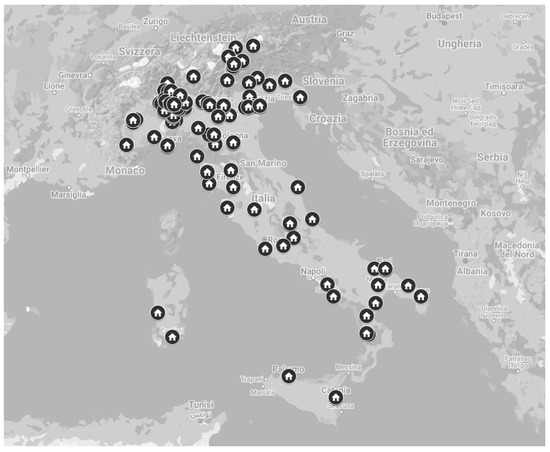
Figure 1.
Distribution of respondents to the questionnaire in Italy.
Moreover, Table 1 shows the percentage of respondents according to the type of city defined according to the number of inhabitants.

Table 1.
Percentage of respondent according to the type of city.
Participants were asked to answer the questionnaire once during the survey. The feedback of all the 330 participants was verified and accepted as valid for the analysis.
The sample of respondents is composed of 56% females and 44% males, aged between 18 and over 66:
- 39% of participants are in the age range 36–45;
- 30% in the range 46–55;
- 19% in the range 26–35;
- 12% in the range 56–65.
Generally, the respondents have a high level of education (Figure 2).
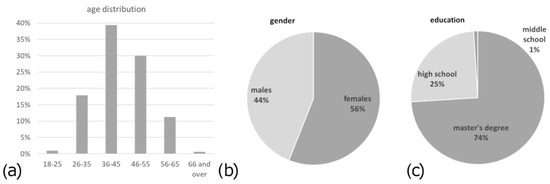
Figure 2.
Sample distribution: (a) age, (b) gender, and (c) level of education.
When the respondents submitted the questionnaire, 75% of them had been WFH for more than 1 month, 22% for more than 2 weeks, and 3% between one and two weeks. The survey shows that only 19% of respondents work alone, and more than 80% share the spaces with other family members; about half of the latter, 38% of the total, share their working life with one or more children (Figure 3).
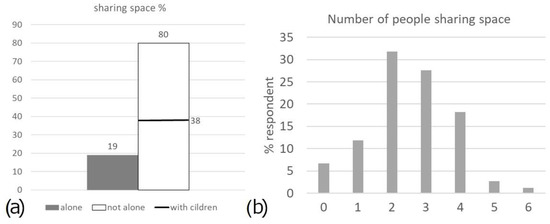
Figure 3.
People sharing space when WFH: (a) general overview and (b) details of number of people.
2.3. Housing Context
Four options were given concerning the house typology: apartment block, detached house, terraced house, and other. About 73% of the participants live in apartments, 18% in detached houses, and only 7% in terraced houses (Figure 4).
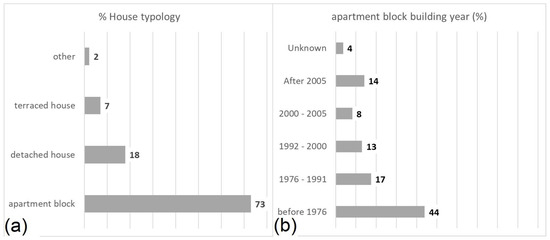
Figure 4.
Housing context in percentage of the data sample: (a) house typology and (b) building year of apartments blocks.
As regards the indoor neighborhood noise, only the apartment blocks (73%, N = 241) have been taken into consideration, since, as they are adjacent to each other (above, below, and to the side), they are more likely to be subject to noise transmission. In fact, terraced houses are less subjected to neighborhood noise, because they only have one common wall, and therefore, we have not taken this house typology into account for this analysis.
The average age of the Italian apartment block buildings is very high (Figure 4). About 44% of the houses were built before 1976, the year in which the Italian government enacted Law 373, regulating the energy performance characteristics of buildings and requiring the installation of double-glazed windows. In December 1997, a national law (DPCM 5/12/1997) also came into force, imposing mandatory sound insulation requirements for all new buildings built after 1998. The extended life cycle of buildings in Italy significantly slows down the process of improving the acoustic performance of buildings. Levels of noise protection in dwellings have improved for several parameters in relation to the entry into force of the legal requirements; such improvement has only been noticeable from 2000 onwards, as highlighted by [12,13].
In [12], the type of building stock in Italy was deep analyzed. They have shown that 90% of the buildings realized in Italy in the post-war to nowadays period have separating walls and outer walls in bricks elements; 95% of buildings have a prefabricated slab floor with brick blocks. About the acoustics performance of the Italian building stock, the following indications were highlighted [12]:
- –
- Facades: An improvement in the acoustic performances occurred after the publication of the first national law on energy consumption in buildings in 1976 (Law 373), which required the use of double glazing. A second improvement was due to the law on energy efficiency in buildings of 1991, which was followed by the 5/12/97 law on acoustic performances of buildings (DPCM 5/12/97) requiring the installation of the best performance glazing on windows.
- –
- Floor sound insulation: The historical analysis of separating floors shows a significant improvement in acoustic performances in the years after the publication of DPCM 5/12/97.
- –
- Floor impact sound insulation: Before 1998, the percentage of realized floating floor was low, with many construction errors. The trend over time shows that, before the publication of Minister Issue n. 1769 (1966), the floors had very poor impact sound insulation.
Our survey shows that 183 respondents indicated that the buildings were built before 2000 and only 51 after 2000 (22% of the total).The combined effect of the two laws, Law 373 for thermal aspects and DPCM 5/12/1997 for acoustic aspects, allow to assume that, since 1976, insulation has improved, especially against external noise, through double-glazed windows and, since 2000, also against internal noise. Therefore, in order to identify a possible improvement in acoustic performance, with reference to Figure 4, it can be assumed that 52% of the respondents (14 + 8 + 13 + 17%) may have benefited from better outdoor sound insulation, but only 22% (8 + 14%) have benefited from both better indoor and outdoor sound insulation. Moreover, we asked the respondent if the residential unit in which you live has been renovated in the last 10 years, and, if so, what type of renovation intervention has been performed. Except for some internal renovations such as painting and furniture, all the interventions regarded the external thermal insulation, which usually has no influence on sound insulation, except for particular cases such as for mineral wool, which can have a slight improvement in façade sound insulation [14] and only if the window is highly insulated. Therefore, we can assume that, in the case of our survey, the above considered percentages are correct.
3. Results
The descriptive analysis concerns (A) noise annoyance during the COVID-19 lockdown, (B) the comparison between the lockdown and pre-lockdown situation, and (C) the perception of the AQ in dwellings used as a working place during the lockdown.
The questionnaire included a question asking who opened the windows for air exchange and, if so, for how long. The results were that, among those who opened the windows, 44% did so for more than an hour, 24% between 30 and 60 min, 28% between 10 and 30 min, and 4% for less than 10 min (Figure 5). We repeated the analysis relating to the perception of outdoor noise considering only the responses of the 56% who did not open the windows, and we obtained the same trend obtained on the whole sample; therefore, the following considerations are valid for the whole sample.
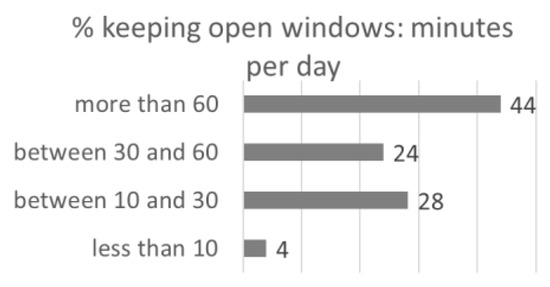
Figure 5.
People keeping windows open.
3.1. Noise Annoyance during Lockdown
The lockdown period is very indicative of the perception of noise, as respondents spent much more time at home than in the pre-lockdown periods (the time spent in the room to WFH is between 6 and 9 h for 71% of respondents). A distinction was made between annoyance by outdoor and indoor noises, as described in detail in the following subsections.
3.1.1. Outdoor Noise
Considering outdoor noise (Figure 6), it can be seen that the noises that are not perceived or only slightly perceived as annoying are related to factories, shops, and restaurants, followed by traffic.

Figure 6.
Annoyance by outdoor noise during the COVID-19 lockdown: (a) whole sample and (b) people who do not open the windows.
This is justified by the decision of the Italian Government to suspend all non-essential activities such as offices, restaurants, cinemas, gyms, etc. and shops with the exception of grocery stores.
The following considerations regard the total of the respondents (Figure 6a).
The data on road traffic noise differ from those on other types of traffic (36% of annoyed). This can be explained by the sirens of the many ambulances driving by during the lockdown period, which is also confirmed by the fact that most respondents live in the north of Italy, which was the area most affected by the epidemic and where the number of ambulances being driven was higher. A similar hypothesis was also reported in the study by [4].
On the contrary, the most perceived and disturbing outdoor noises are those of anthropogenic origin (shouting, children playing, etc.), which 52% of respondents find annoying, and those of domestic animals (barking dogs, 38% annoyed). This can be explained by the fact that more children play outside, as they do not have to go to school, and that many people take their dogs outside, thus getting around the prohibition to leave their home. Even those of natural origin are significantly perceived (by 61% of respondents) but without being annoying (29%).
3.1.2. Indoor Noise
Indoor noises (Figure 7) that are not perceived or not annoying are mainly those generated by indoor and equipment devices. This may be justified by assuming the absence of continuously operating systems (air conditioning or air exchange) that usually generate more noise; there is no direct feedback on it, but as the lockdown was in the winter, the only operating systems were the heaters, which are generally not noisy.
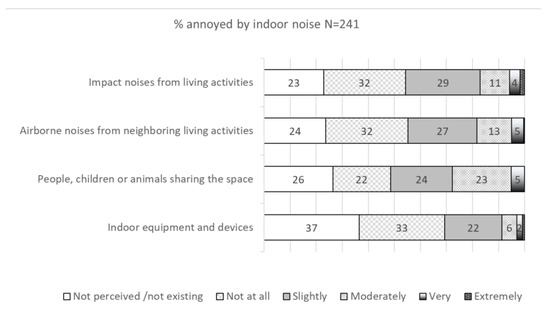
Figure 7.
Annoyance by indoor noise during COVID-19 lockdown.
Airborne and impact noises coming from neighboring dwellings are perceived and partly annoying (38–39%), while 50% of respondents say they are annoyed by people, children, or animals who share the space.
It is interesting to analyze how the presence of children influences the answers regarding annoyance from neighbors and cohabitants (Figure 8). Most of the children who share the space are under six years old (30%) and between six and twelve years old (28%). In situations with children (38% of the total), there is an increase in “moderately” and “highly perceived” responses: 49% compared to 11% of respondents without children (62% of the total).

Figure 8.
Answers regarding the annoyance from neighbors and cohabitants: influence of the presence of children: (a) all respondents, (b) respondents with children, and (c) respondents without children.
3.2. Changes between Pre-Lockdown and Lockdown Periods
Figure 9 shows how annoyances due to the different individual noise sources changed compared to pre-lockdown conditions, distinguishing between indoor and outdoor noise sources. As shown in Figure 9, the majority of respondents (on average about 70%) stated that they did not notice any changes between the lockdown and pre-lockdown periods. However, it is significant that, according to the respondents who were more annoyed, the annoyance was caused by the noises inside the building rather than to those coming from outside.
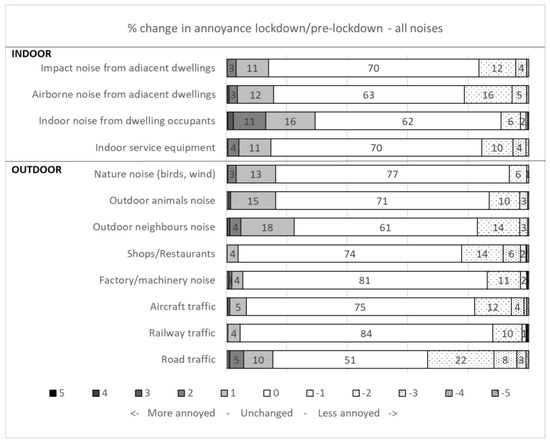
Figure 9.
Changes in annoyance with different indoor and outdoor noise sources during lockdown compared to pre-lockdown.
The analysis of the effect of noises inside the building shows that the greatest annoyance is due to the noise caused by the other occupants of the apartment. Regarding outdoor noise, on the other hand, traffic noise is, in general, perceived less than noise caused by shouting, animals, and sounds of nature. The analysis of outdoor noise sources (Figure 9) shows that, during the lockdown, the annoyance from neighborhood noise, from pets’ noise (dogs, etc.), and from the sounds of nature increased (about 18% more disturbed). On the contrary, other outdoor noise sources, especially traffic noise, noise from factories, and from bars and restaurants (about 20% less disturbed), are less perceived during the lockdown than in the previous period, as expected.
For the indoor noise, the increase in annoyance during the lockdown period is mainly determined by people sharing the space with those working from home (about 29% more disturbed, 9% less disturbed), while there does not seem to be much difference for other sources, including those from nearby apartments (on average, 15% more disturbed, 18% less disturbed).
A paired t-test was performed on all the respondents (N = 330) to determine how significant differences are in the annoyance levels between the lockdown period and the pre-lockdown period, focusing, in particular, on indoor and outdoor noises. The results of the paired t-test are summarized in Table 2.

Table 2.
Results of the paired t-test on the differences between the lockdown period and the pre-lockdown periods.
The null hypothesis of the paired t-test is that the mean difference between pairs is zero. Our null hypothesis is that there is no difference between the pre-lockdown and lockdown situations.
Box plots in Figure 10 show the noise annoyance levels during the lockdown and the pre-lockdown periods. The statistical analysis (see Table 2) confirms that the perception of noise caused by those who share the living space is significantly greater in the lockdown period than in the pre-lockdown period; on the other hand, the annoyance caused by road traffic noise is significantly greater in the pre-lockdown period than in the lockdown period. Finally, there is no significant difference in annoyance caused by both indoor and outdoor noise from the neighborhood.

Figure 10.
Boxplots of scores for the comparison lockdown/pre-lockdown: 0 = not annoyed, 5 = extremely annoyed: (a) indoor neighborhood airborne noise, (b) outdoor neighborhood noises, (c) road traffic noise, and (d) noise from people sharing the living space.
3.3. Perception of the Acoustic Quality during the Lockdown
The aspect related to the age of the building was considered; given the considerations made in Section 2 above on improving acoustic performance in buildings, it was decided to reduce the significant time frame for the descriptive analysis regarding the age of the building from 2000 to date (22% of respondents). Figure 11 underlines a better quality expressed by those who live and work in buildings built after 2000, confirming the trend indicated by [12,13] for the improvement of the acoustic performance of buildings in Italy over time; in particular, they are more satisfied with the quality of the apartment (Figure 11a), they believe that the quality of the room where they work is better (Figure 11b), and they require fewer changes (Figure 11c).

Figure 11.
Houses built before and after 2000: (a) perception of the acoustic quality, (b) acoustic quality of the rooms worked in, and (c) desired improvements in rooms worked in.
The impact of AQ when WFH was analyzed based on the answers to the following question: “How does the acoustic quality of the room interfere with the ability to work from home?” Figure 12 shows that about 69% think that the AQ of their apartment interferes with their ability to work. For most of them, a better quality could improve their work performance; in fact, more than half take measures (headphones, closing the door, and other) to ensure acoustic privacy.
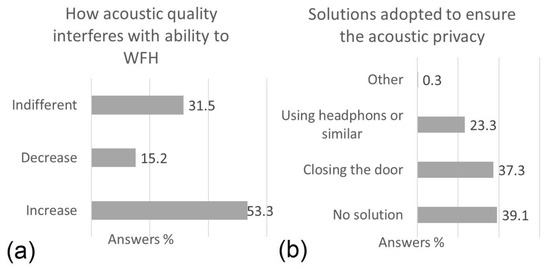
Figure 12.
Impact of AQ on WFH: (a) Interference with ability to WFH and privacy and (b) solutions adopted to ensure the acoustic privacy.
Finally, two last questions were examined:
- “In defining how satisfied you are with the environment, what importance did you attach to the acoustic aspects?”;
- “Has Working from home (WFH) influenced your perception of acoustic comfort?”.
Three quarters of the respondents attached great importance to the acoustic aspects when assessing the quality of their living environment (Figure 13a); moreover, more than half of the respondents indicated that the WHF condition was most likely to have influenced their perception of acoustic comfort (Figure 13b).
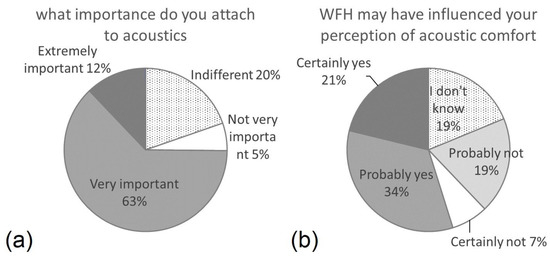
Figure 13.
Environment satisfaction: (a) Importance of the acoustic aspects and (b) influence of WFH on the perception of acoustic comfort.
Taking into account that the main cause of disturbance was indoor noise, it can be deduced that this had the greatest impact on the ability of the participants to work from home; a similar conclusion can be found in [4].
4. Discussion and Conclusions
The significance of this survey on the AQ of buildings is confirmed by the importance that respondents attach to the acoustic aspects when assessing their general satisfaction with the living environment (see Figure 13a).
More specifically, most respondents indicated that they were satisfied or very satisfied with the environment in which they work, although 50% believe that an improvement is necessary. As expected, a better judgment is expressed by those who live and work in buildings built after 2000, confirming the better AQ of buildings built starting from that year [12,13].
Furthermore, most respondents believe that the AQ of their home can improve their work performance, even if more than half of them take measures (headphones, closing the door, and other) to ensure acoustic privacy. This would confirm that WFH is affected more by the acoustic environment than by relaxation, in line with the main findings of [11] and in contrast to the findings of [4], where only 25% of respondents reported that noise conditions negatively affected their ability to work from home.
The annoyance during the lockdown period was first analyzed. Regarding the outdoor noise sources, traffic noise is not disturbing (apart from the sirens of the ambulances), confirming the fact that during the lockdown the circulation of cars was not allowed, and the same applies to noises from factories, shops, and restaurants because of the suspension of any work activity other than the essential ones.
The other sources of external noise then take over—in particular, those of anthropogenic origin (shouting, children playing, etc.); noises of pets; and above all, those of natural origin; a similar trend has been confirmed by other studies [4,15]. This result is not very significant due to an actual increase in these noises as to their greater perception due to the absence of traffic noise. Actually, during the lockdown, Italy was among the countries where the impact on the circulation of cars was the greatest (in this period, population mobility was reduced by about 90%. Apple data: www.apple.com/covid19/mobility, accessed on 29 March 2022).
With regard to indoor noise, most respondents report being disturbed by people, children, or animals sharing the home; a similar trend has been confirmed by other studies [4,15]. In our survey, this is confirmed, in particular, by the fact that 80% of participants carry out their work activities sharing their spaces with other family members; in particular, respondents with children (almost half of those who share their spaces with family members share their work life with one or more children) are more disturbed than those without children.
The impact of children is also confirmed by some open-ended answers: “bringing together smart working and (the presence of) very young children (3–4 years) is difficult and productivity often suffers from it”; “closed schools are the main cause of discomfort”; “the presence of minors certainly affects performance”; “smart working (...) with school-age children to attend to, it’s a nightmare”.
This is because, on the one hand, kids ask for parental attention, and on the other hand, children need to be looked after during distance learning.
From the comparison between the pre-lockdown and the lockdown periods, first of all, the majority of respondents found that there was no change between the two periods. This may be explained by the fact that questions about the pre-lockdown period were asked during the lockdown, and even if respondents could easily remember their pre-lockdown situations, the majority of respondents spent less time at home during the pre-lockdown period, and probably, their judgment on this period might be less reliable.
According to some of the respondents who noticed a difference between the two periods, it seems that, during the lockdown, the noise coming from inside the building prevailed over that from the outside. When analyzing the indoor noise in detail, the largest increase is attributed to noise caused by people sharing the apartment.
The descriptive approach highlighted that the impact of indoor noises on the ability of the participants to work from home is greater, especially if caused by the presence of children or roommates. Regarding the ability of the dwelling to insulate against noise, the survey seems to indicate that most of the respondents believe the AQ of the inhabited environment to be good or acceptable, at least for the building context examined, i.e., a renovated apartment block with windows with a satisfactory insulating performance, and considering the particular conditions of working from home.
Taking into account the inevitable limitations due to the small size of the sample investigated, which could also lead to some kind of bias, since, as reported in [16], different demographic backgrounds of respondents can influence the answers to a questionnaire, this study confirms the results of other similar studies, both in Italy and in other countries.
Other publications from different countries have reported about similar topics (acoustic issues during COVID-19) by way of surveys conducted following different approaches; Bartalucci [2] and Torresin [14] analyzed the soundscape, the latter focusing on the indoor environment. Maggi [7] analyzed the environmental noise by investigating the pleasantness regarding the acoustic environment during the lockdown. Finally, Şentop Dümen [8], P. J. Lee [17], and Andargie [4] investigated the change of annoyance level between before and during the lockdown, the latter being limited to the indoor noise in multi-unit residential buildings. Only Lee and Andargie used both pre-COVID-19 and during-COVID-19 data for comparison in a sample that was otherwise very limited (N = 100 and N = 48, respectively). Concerning the type of noises that have increased and decreased during the lockdown, the results found by Maggi, Şentop Dümen, Lee, and Andargie were in line with the results of our research; the main difference is that the pool of respondents in our case is composed of people working from home.
Finally, this study has demonstrated the impact of indoor sound quality in living spaces and, therefore, the necessity to address improvements in indoor sound quality either through policy and/or building best practices. The Italian acoustics community knows very well this important issue, and in January 2023, the new version of the standard UNI 11367 on the acoustics classification was published. Moreover, the Italian government recognized this importance recalling of UNI 11367 in the new Decree on the minimum environmental criteria (CAM) for the assignment of design services for building interventions, for the assignment of works for building interventions, and for the joint assignment of designs and works for building interventions.
Author Contributions
Conceptualization, F.S. (Fabio Scamoni); methodology, F.S. (Fabio Scamoni). and C.S.; software, F.S. (Francesco Salamone); validation, F.S. (Fabio Scamoni) and C.S.; formal analysis, F.S. (Fabio Scamoni) and C.S.; data curation, F.S. (Fabio Scamoni), F.S. (Fabio Scamoni) and C.S.; writing—original draft preparation, F.S. (Fabio Scamoni); writing—review and editing, F.S. (Fabio Scamoni), F.S. (Francesco Salamone) and C.S. All authors have read and agreed to the published version of the manuscript.
Funding
This research received no external funding.
Data Availability Statement
The data presented in this study are available on request from the corresponding author.
Acknowledgments
We gratefully acknowledge Paolo Cardillo for revising the English text of the manuscript.
Conflicts of Interest
The authors declare no conflict of interest.
Appendix A. Questions and Answers
In this appendix, the questions included in the questionnaire on Acoustic Quality and all the possible answers are listed. Moreover, the references used in the questionnaire are included (e.g., Acoustics_47 means that the question is related to acoustics and is question n. 47).

Table A1.
Questions included in the questionnaire on Acoustic Quality.
Table A1.
Questions included in the questionnaire on Acoustic Quality.
| Question Reference | Question | Possible Answers |
|---|---|---|
| Acoustic_47 | Thinking about the PRESENT period, when you are at home, how much does noise from road traffic, bother, disturb or annoy you? | Not perceived/not existing Not at all Little Moderately Very Extremely |
| Acoustic_48 | Thinking about the PRESENT period, when you are at home, how much does noise from railway traffic, bother, disturb or annoy you? | Not perceived/not existing Not at all Little Moderately Very Extremely |
| Acoustic_49 | Thinking about the PRESENT period, when you are at home, how much does noise from airplane overflights, bother, disturb or annoy you? | Not perceived/not existing Not at all Little Moderately Very Extremely |
| Acoustic_50 | Thinking about the PRESENT period, when you are at home, how much does noise from factories/machinery, bother, disturb or annoy you? | Not perceived/not existing Not at all Little Moderately Very Extremely |
| Acoustic_51 | Thinking about the PRESENT period, when you are at home, how much does noise from shops, bars, restaurants, bother, disturb or annoy you? | Not perceived/not existing Not at all Little Moderately Very Extremely |
| Acoustic_52 | Thinking about the PRESENT period, when you are at home, how much does noise from neighborhood from outside (voices, children playing, …) bother, disturb or annoy you? | Not perceived/not existing Not at all Little Moderately Very Extremely |
| Acoustic_53 | Thinking about the PRESENT period, when you are at home, how much does noise from animals from outside (dogs barking, rooster singing, …), bother, disturb or annoy you? | Not perceived/not existing Not at all Little Moderately Very Extremely |
| Acoustic_54 | Thinking about the PRESENT period, when you are at home, how much does noise from sound of nature (chirping of birds, rustling of the wind, …), bother, disturb or annoy you? | Not perceived/not existing Not at all Little Moderately Very Extremely |
| Acoustic_55 | Thinking about the PRESENT period, when you are at home, how much does noise from plants, equipment and devices in the room, bother, disturb or annoy you? | Not perceived/not existing Not at all Little Moderately Very Extremely |
| Acoustic_56 | Thinking about the PRESENT period, when you are at home, how much does noise from people, children or animals sharing the room, bother, disturb or annoy you? | Not perceived/not existing Not at all Little Moderately Very Extremely |
| Acoustic_57 | Thinking about the PRESENT period, when you are at home, how much does airborne noise from the neighborhood (sounds, voices, television, music, …), bother, disturb or annoy you? | Not perceived/not existing Not at all Little Moderately Very Extremely |
| Acoustic_58 | Thinking about the PRESENT period, when you are at home, how much does impact noise from the neighborhood steps of children running, heels, clogs, ball, noise of falling objects, …), bother, disturb or annoy you? | Not perceived/not existing Not at all Little Moderately Very Extremely |
| Acoustic_59 | Thinking about the period PREVIOUS to the adoption of the Prime Ministerial Decree 5 March 2020 and subsequent amendments, when you are at home, how much does noise from road traffic, bother, disturb or annoy you? | Not perceived/not existing Not at all Little Moderately Very Extremely |
| Acoustic_60 | Thinking about the period PREVIOUS to the adoption of the Prime Ministerial Decree 5 March 2020 and subsequent amendments, when you are at home, how much does noise from railway traffic, bother, disturb or annoy you? | Not perceived/not existing Not at all Little Moderately Very Extremely |
| Acoustic_61 | Thinking about the period PREVIOUS to the adoption of the Prime Ministerial Decree 5 March 2020 and subsequent amendments, when you are at home, how much does noise from airplane overflights, bother, disturb or annoy you? | Not perceived/not existing Not at all Little Moderately Very Extremely |
| Acoustic_62 | Thinking about the period PREVIOUS to the adoption of the Prime Ministerial Decree 5 March 2020 and subsequent amendments, when you are at home, how much does noise from factories/machinery, bother, disturb or annoy you? | Not perceived/not existing Not at all Little Moderately Very Extremely |
| Acoustic_63 | Thinking about the period PREVIOUS to the adoption of the Prime Ministerial Decree 5 March 2020 and subsequent amendments, when you are at home, how much does noise from shops, bars, restaurants, bother, disturb or annoy you? | Not perceived/not existing Not at all Little Moderately Very Extremely |
| Acoustic_64 | Thinking about the period PREVIOUS to the adoption of the Prime Ministerial Decree 5 March 2020 and subsequent amendments, when you are at home, how much does noise from neighborhood from outside (voices, children playing, …) bother, disturb or annoy you? | Not perceived/not existing Not at all Little Moderately Very Extremely |
| Acoustic_65 | Thinking about the period PREVIOUS to the adoption of the Prime Ministerial Decree 5 March 2020 and subsequent amendments, when you are at home, how much does noise from animals from outside (dogs barking, rooster singing, …), bother, disturb or annoy you? | Not perceived/not existing Not at all Little Moderately Very Extremely |
| Acoustic_66 | Thinking about the period PREVIOUS to the adoption of the Prime Ministerial Decree 5 March 2020 and subsequent amendments, when you are at home, how much does noise from sound of nature (chirping of birds, rustling of the wind, …), bother, disturb or annoy you? | Not perceived/not existing Not at all Little Moderately Very Extremely |
| Acoustic_67 | Thinking about the period PREVIOUS to the adoption of the Prime Ministerial Decree 5 March 2020 and subsequent amendments, when you are at home, how much does noise from plants, equipment and devices in the room, bother, disturb or annoy you? | Not perceived/not existing Not at all Little Moderately Very Extremely |
| Acoustic_68 | Thinking about the period PREVIOUS to the adoption of the Prime Ministerial Decree 5 March 2020 and subsequent amendments, when you are at home, how much does noise from people, children or animals sharing the environment the room, bother, disturb or annoy you? | Not perceived/not existing Not at all Little Moderately Very Extremely |
| Acoustic_69 | Thinking about the period PREVIOUS to the adoption of the Prime Ministerial Decree 5 March 2020 and subsequent amendments, when you are at home, how much does airborne noise from the neighborhood (sounds, voices, television, music, …), bother, disturb or annoy you? | Not perceived/not existing Not at all Little Moderately Very Extremely |
| Acoustic_70 | Thinking about the period PREVIOUS to the adoption of the Prime Ministerial Decree 5 March 2020 and subsequent amendments, when you are at home, how much does impact noise from the neighborhood steps of children running, heels, clogs, ball, noise of falling objects, …), bother, disturb or annoy you? | Not perceived/not existing Not at all Little Moderately Very Extremely |
References
- Salamone, F.; Barozzi, B.; Bellazzi, A.; Belussi, L.; Danza, L.; Devitofrancesco, A.; Ghellere, M.; Meroni, I.; Scamoni, F.; Scrosati, C. Working from home in Italy during COVID-19 lockdown: A survey to assess the indoor environmental quality and productivity. Buildings 2021, 11, 660. [Google Scholar] [CrossRef]
- Bartalucci, C.; Bellomini, R.; Luzzi, S.; Pulella, P.; Torelli, G. A survey on the soundscape perception before and during the COVID-19 pandemic in Italy. Noise Mapp. 2021, 8, 65–88. [Google Scholar] [CrossRef]
- Aletta, F.; Brinchi, S.; Carrese, S.; Gemma, A.; Guattari, C.; Mannini, L.; Patella, S. Analysing urban traffic volumes and mapping noise emissions in Rome (Italy) in the context of containment measures for the COVID-19 disease. Noise Mapp. 2020, 7, 114–122. [Google Scholar] [CrossRef]
- Andargie, M.; Touchie, M.; O’Brien, W. Case study: A survey of perceived noise in Canadian multi-unit residential buildings to study long-term implications for widespread teleworking. Build. Acoust. 2021, 28, 443–460. [Google Scholar] [CrossRef]
- Bartalucci, C.; Borchi, F.; Carfagni, M. Noise monitoring in Monza (Italy) during COVID-19 pandemic by means of the smart network of sensors developed in the LIFE MONZA project. Noise Mapp. 2020, 7, 199–211. [Google Scholar] [CrossRef]
- Zambrano-Monserrate, M.; Ruano, M.; Sanchez-Alcalde, L. Indirect effects of COVID-19 on the environment. Sci. Total Environ. 2020, 728, 138813. [Google Scholar] [CrossRef] [PubMed]
- Maggi, A.; Muratore, J.; Gaetán, S.; Zalazar-Jaime, M.; Evin, D.; Villalobo, J.P.; Hinalaf, M. Perception of the acoustic environment during COVID-19 lockdown in Argentina. J. Acoust. Soc. Am. 2021, 149, 3902–3909. [Google Scholar] [CrossRef] [PubMed]
- Dümen, A.Ş.; Şaher, K. Noise annoyance during COVID-19 lockdown: A research of public opinion before and during the pandemic. J. Acoust. Soc. Am. 2020, 148, 3489–3496. [Google Scholar] [CrossRef] [PubMed]
- Tong, H.; Aletta, F.; Mitchell, A.; Oberman, T.; Kang, J. Increases in noise complaints during the COVID-19 lockdown in Spring 2020: A case study in Greater London, UK. Sci. Total Environ. 2021, 785, 147213. [Google Scholar] [CrossRef]
- Dümen, A.S.; Saher, K. Noise annoyance in dwellings during the first wave of COVID-19. J. Acoust. Soc. Am. 2021, 149, A51. [Google Scholar] [CrossRef]
- Torresin, S.; Albatici, R.; Aletta, F.; Babich, F.; Oberman, T.; Stawinoga, A.; Kang, J. Indoor soundscapes at home during the COVID-19 lockdown in London—Part I: Associations between the perception of the acoustic environment, occupantś activity and well-being. Appl. Acoust. 2021, 183, 108305. [Google Scholar] [CrossRef] [PubMed]
- Nannipieri, E.; Secchi, S. The evolution of acoustic comfort in Italian houses. Build. Acoust. 2012, 19, 99–118. [Google Scholar] [CrossRef]
- Di Bella, A.; Fausti, P.; Scamoni, F.; Secchi, S. Italian experiences on acoustic classification of buildings. In Proceedings of the Inter Noise Congress, New York, NY, USA, 19–22 August 2012. [Google Scholar]
- Scamoni, F.; Scrosati, C.; Depalma, M.; Bellazzi, A.; Gandolfi, R. Sound insulation improvement of a facade with external thermal insulation system. In Proceedings of the 27th International Congress on Sound and Vibration, ICSV, Virtual, 11–16 July 2021. [Google Scholar]
- Torresin, S.; Albatici, R.; Aletta, F.; Babich, F.; Oberman, T.; Stawinoga, A.; Kang, J. Indoor soundscapes at home during the COVID-19 lockdown in London—Part II: A structural equation model for comfort, content, and well-being. Appl. Acoust. 2022, 185, 108379. [Google Scholar] [CrossRef] [PubMed]
- Bujang, A.A.; Zarin, H.A.; Jumadi, N. The relationship between demographic factors and housing affordability. Malays. J. Real Estate 2010, 5, 49–58. [Google Scholar]
- Lee, P.; Jeong, J. Attitudes towards outdoor and neighbour noise during the COVID-19 lockdown: A case study in London. Sustain. Cities Soc. 2021, 67, 102768. [Google Scholar] [CrossRef] [PubMed]
Disclaimer/Publisher’s Note: The statements, opinions and data contained in all publications are solely those of the individual author(s) and contributor(s) and not of MDPI and/or the editor(s). MDPI and/or the editor(s) disclaim responsibility for any injury to people or property resulting from any ideas, methods, instructions or products referred to in the content. |
© 2023 by the authors. Licensee MDPI, Basel, Switzerland. This article is an open access article distributed under the terms and conditions of the Creative Commons Attribution (CC BY) license (https://creativecommons.org/licenses/by/4.0/).